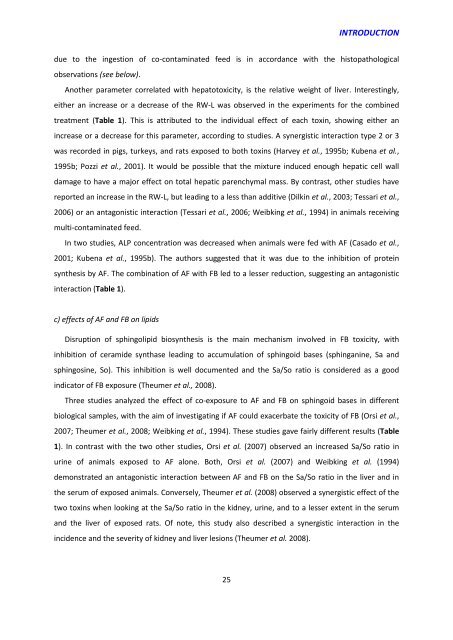Effet chez le porcelet d'une exposition à un régime co-contaminé en ...
Effet chez le porcelet d'une exposition à un régime co-contaminé en ...
Effet chez le porcelet d'une exposition à un régime co-contaminé en ...
Create successful ePaper yourself
Turn your PDF publications into a flip-book with our unique Google optimized e-Paper software.
INTRODUCTIONdue to the ingestion of <strong>co</strong>-<strong>co</strong>ntaminated feed is in ac<strong>co</strong>rdance with the histopathologicalobservations (see below).Another parameter <strong>co</strong>rrelated with hepatotoxicity, is the relative weight of liver. Interestingly,either an increase or a decrease of the RW-L was observed in the experim<strong>en</strong>ts for the <strong>co</strong>mbinedtreatm<strong>en</strong>t (Tab<strong>le</strong> 1). This is attributed to the individual effect of each toxin, showing either anincrease or a decrease for this parameter, ac<strong>co</strong>rding to studies. A synergistic interaction type 2 or 3was re<strong>co</strong>rded in pigs, turkeys, and rats exposed to both toxins (Harvey et al., 1995b; Kub<strong>en</strong>a et al.,1995b; Pozzi et al., 2001). It would be possib<strong>le</strong> that the mixture induced <strong>en</strong>ough hepatic cell walldamage to have a major effect on total hepatic par<strong>en</strong>chymal mass. By <strong>co</strong>ntrast, other studies havereported an increase in the RW-L, but <strong>le</strong>ading to a <strong>le</strong>ss than additive (Dilkin et al., 2003; Tessari et al.,2006) or an antagonistic interaction (Tessari et al., 2006; Weibking et al., 1994) in animals receivingmulti-<strong>co</strong>ntaminated feed.In two studies, ALP <strong>co</strong>nc<strong>en</strong>tration was decreased wh<strong>en</strong> animals were fed with AF (Casado et al.,2001; Kub<strong>en</strong>a et al., 1995b). The authors suggested that it was due to the inhibition of proteinsynthesis by AF. The <strong>co</strong>mbination of AF with FB <strong>le</strong>d to a <strong>le</strong>sser reduction, suggesting an antagonisticinteraction (Tab<strong>le</strong> 1).c) effects of AF and FB on lipidsDisruption of sphingolipid biosynthesis is the main mechanism involved in FB toxicity, withinhibition of ceramide synthase <strong>le</strong>ading to accumulation of sphingoid bases (sphinganine, Sa andsphingosine, So). This inhibition is well docum<strong>en</strong>ted and the Sa/So ratio is <strong>co</strong>nsidered as a goodindicator of FB exposure (Theumer et al., 2008).Three studies analyzed the effect of <strong>co</strong>-exposure to AF and FB on sphingoid bases in differ<strong>en</strong>tbiological samp<strong>le</strong>s, with the aim of investigating if AF <strong>co</strong>uld exacerbate the toxicity of FB (Orsi et al.,2007; Theumer et al., 2008; Weibking et al., 1994). These studies gave fairly differ<strong>en</strong>t results (Tab<strong>le</strong>1). In <strong>co</strong>ntrast with the two other studies, Orsi et al. (2007) observed an increased Sa/So ratio inurine of animals exposed to AF alone. Both, Orsi et al. (2007) and Weibking et al. (1994)demonstrated an antagonistic interaction betwe<strong>en</strong> AF and FB on the Sa/So ratio in the liver and inthe serum of exposed animals. Conversely, Theumer et al. (2008) observed a synergistic effect of thetwo toxins wh<strong>en</strong> looking at the Sa/So ratio in the kidney, urine, and to a <strong>le</strong>sser ext<strong>en</strong>t in the serumand the liver of exposed rats. Of note, this study also described a synergistic interaction in theincid<strong>en</strong>ce and the severity of kidney and liver <strong>le</strong>sions (Theumer et al. 2008).25

















